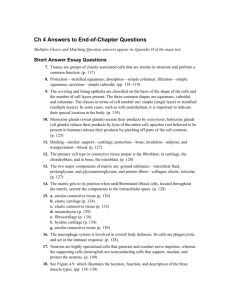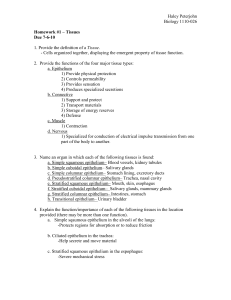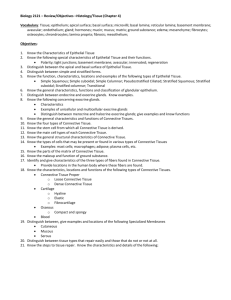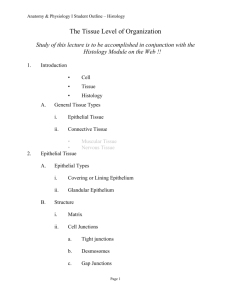Keshal Patel BY 115 SI Session1.3 1) Through the process of cell
advertisement
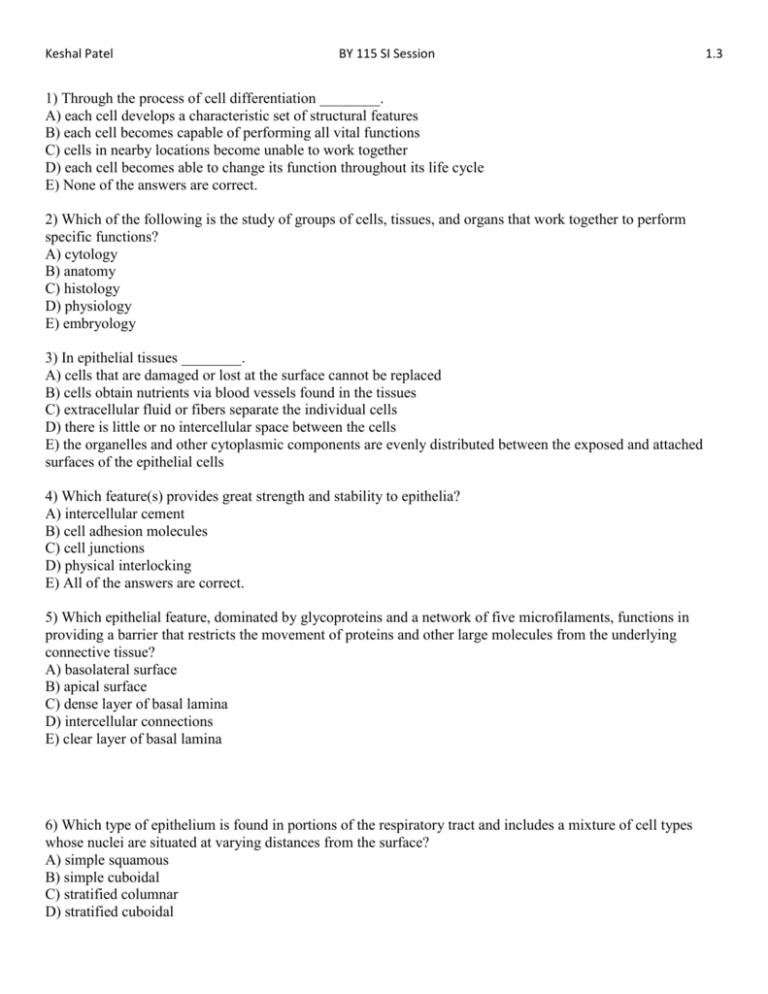
Keshal Patel BY 115 SI Session 1) Through the process of cell differentiation ________. A) each cell develops a characteristic set of structural features B) each cell becomes capable of performing all vital functions C) cells in nearby locations become unable to work together D) each cell becomes able to change its function throughout its life cycle E) None of the answers are correct. 2) Which of the following is the study of groups of cells, tissues, and organs that work together to perform specific functions? A) cytology B) anatomy C) histology D) physiology E) embryology 3) In epithelial tissues ________. A) cells that are damaged or lost at the surface cannot be replaced B) cells obtain nutrients via blood vessels found in the tissues C) extracellular fluid or fibers separate the individual cells D) there is little or no intercellular space between the cells E) the organelles and other cytoplasmic components are evenly distributed between the exposed and attached surfaces of the epithelial cells 4) Which feature(s) provides great strength and stability to epithelia? A) intercellular cement B) cell adhesion molecules C) cell junctions D) physical interlocking E) All of the answers are correct. 5) Which epithelial feature, dominated by glycoproteins and a network of five microfilaments, functions in providing a barrier that restricts the movement of proteins and other large molecules from the underlying connective tissue? A) basolateral surface B) apical surface C) dense layer of basal lamina D) intercellular connections E) clear layer of basal lamina 6) Which type of epithelium is found in portions of the respiratory tract and includes a mixture of cell types whose nuclei are situated at varying distances from the surface? A) simple squamous B) simple cuboidal C) stratified columnar D) stratified cuboidal 1.3 Keshal Patel BY 115 SI Session E) pseudostratified columnar 7) Which of the following exclusively describes stratified epithelia? A) They consist of a single cell layer. B) They always have a free surface exposed to some inner chamber or passageway. C) They are avascular. D) They cover surfaces subjected to mechanical and chemical stress. E) None of the answers are correct. 8) The presence of large numbers of microvilli on the exposed surfaces of epithelial cells indicates that ________. A) it is an area where absorption and secretion occur B) these cells provide energy for transport activities C) these cells are probably located along portions of the respiratory tract from the lungs toward the throat D) All of the answers are correct. E) None of the answers are correct. 10) Which type of epithelium is present where easy exchange of materials out of the blood is most important, such as that in the lining of the heart and all blood vessels? A) stratified squamous epithelium B) columnar epithelium C) cuboidal epithelium D) endothelium E) simple epithelium 11) Epithelial cells usually have ________. A) a basal lamina B) unevenly distributed organelles C) apical and basal plasmalemmae with different associated proteins and functions D) an exposed apical surface E) All of the answers are correct. 1.3 Keshal Patel BY 115 SI Session 13) Merocrine sweat glands are classified as which of the following? A) simple alveolar B) simple tubular C) simple coiled tubular D) simple branched alveolar E) simple branched tubular 15) What type of tissue comprises the inner lining of the ventral body cavity? A) simple squamous epithelium B) stratified epithelium C) columnar epithelium D) mesothelium E) endothelium 17) The tissue lining the small intestine of the digestive tract is called ________. A) stratified squamous epithelium B) simple columnar epithelium C) stratified columnar epithelium D) simple squamous epithelium E) None of the answers are correct. 18) Hormones are examples of ________ secretion. A) exocrine B) endocrine C) holocrine D) merocrine E) apocrine 19) What is the simplest multicellular exocrine gland called? A) tubular glands B) secretory sheet C) acinar glands D) alveolar glands E) simple coiled tubular 20) Unicellular exocrine glands are ________. A) mixed exocrine glands B) connected to a surface by ducts C) also called goblet cells D) arranged in a secretory sheet E) None of the answers are correct. 22) Functions of connective tissue include ________. A) establishing a structural framework for the body B) transporting fluid and dissolved materials from one body region to another C) protecting delicate organs D) supporting, surrounding, and interconnecting tissue types E) All of the answers are correct. 1.3 Keshal Patel BY 115 SI Session 23) Which of the following cells can be found in connective tissue? A) mesenchymal cells B) fibroblasts C) eosinophils D) mast cells E) All of the answers are correct. 24) Loose connective tissue proper contains ________. A) fixed and wandering cells B) a tight framework C) parallel, packed fibers D) a solid ground substance E) only elastic fibers 25) Most energy storage in the body is accomplished by which of the following cells? A) adipocytes B) melanocytes C) macrophages D) fibroblasts E) lymphocytes 26) Small, mobile connective tissue cells that release chemicals (after injury or infection), which mediate the inflammatory response, are known as ________. A) lymphocytes B) adipocytes C) microphages D) free macrophages E) mast cells 27) The type of cartilage that is specialized to resist compression is ________. A) osteocartilage B) fibrocartilage C) elastic cartilage D) hyaline cartilage E) All of the answers are correct. 1.3 Keshal Patel BY 115 SI Session 1.3 29) Which of the following comprises a list of the most closely related connective tissue types? A) adipose tissue, tendon, blood, lymph, bone B) elastic cartilage, fibrocartilage, skin C) tendon, blood, lymph, reticular tissue D) areolar tissue, tendon, bone, cartilage E) reticular tissue, dense elastic connective tissue proper, adipose tissue 30) Membranes are formed by the combination of which tissues? A) epithelial and connective B) epithelial and muscle C) connective and muscle D) muscle and neural E) connective and neural 32) Which of the following describes the major function of serous membranes? A) Each consists of a mesothelium supported by dense connective tissue. B) They line body cavities that communicate with the exterior. C) They are loosely attached to the body wall and to the organs they cover. D) Their parietal and visceral portions never touch. E) Tiny amounts of transudate formed on the surfaces of the membrane reduce friction. 35) Connective tissues form the internal framework of the body that does which of the following? A) provides strength and stability B) maintains the relative positions of internal organs C) provides a route for the distribution of blood vessels, lymphatic vessels, and nerves D) All of the answers are correct. E) None of the answers are correct. 36) Connective tissue layers that lie between deep fascia and serous membranes, and line body cavities is called ________. A) superficial fascia B) intermuscular fascia C) subcutaneous layer D) subserous fascia E) hypodermis



